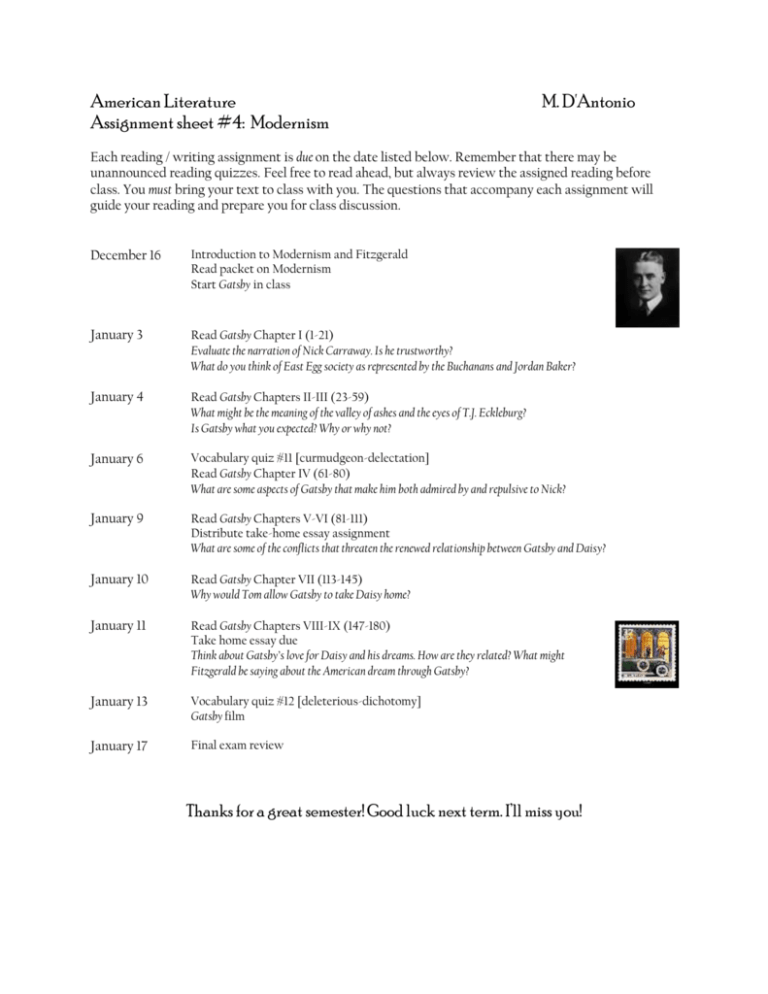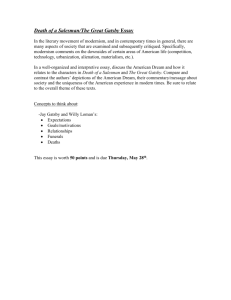- Reviewing the New Fiction
- Looking Back . . .
- Who's Who?
- Style and Substance
- Reading Well
- The New Fiction Module Review
- Features First

Reading Modernism
Use the knowledge and skills you've gained during this module to complete this project.
The poet Ezra Pound uttered the rallying cry for the Modernist movement when he called upon writers to "Make it new!" In this module, you read and analyzed stories by 20th-century American writers who "made it new" in various ways. You also examined how these writers used new styles and themes to speak important truths about the challenges and changes of modern American life.

Suppose your town's public library system asks you to share your new knowledge of Modernist fiction. They are launching a Modern Fiction Book Club and inviting local teens and adults to meet online or at the library to discuss works of Modernist fiction like the stories you read for this module. The goal of the book club is to introduce readers to 20th-century American classics and to help them understand these works' role in shaping more contemporary American literature. Your assignment is to write a reader's guide for a 20th-century short story by a Modernist American author. The good news is that the library's program director is not picky about which author or work you choose as your focus. For the purpose of this assignment, though, you should select a story that you did not read for this module, although you may select one by one of the authors in the module.
Here's an example of the type of introduction and questions your reader's guide should include.
Reader's Guide for "The Black Ball" by Ralph Ellison
The main character of "The Black Ball" is a single father named John who works as a maintenance man at an apartment building, living in a small and shabby apartment over the garage. John's main concern is the well-being of his young son. He is careful to avoid offending the racist apartment building manager because John can't afford to lose his job. However, an unexpected visit from a stranger and a disturbing incident with the manager cause John to look more toward the future.
Sample Question: In the 1950s, discrimination against African Americans was a tragic fact of American life. By the end of the story, how does the narrator of "The Black Ball" decide to deal with the limits that racism imposes on him and his son?
You may select your story from the list below, or you may search online for other stories by the Modernist fiction writers you studied in this module: Ernest Hemingway, F. Scott Fitzgerald, Katherine Anne Porter, Carson McCullers, Ralph Ellison, Flannery O'Connor, or Shirley Jackson.
Regardless of the story you choose to introduce, your reader's guide should accomplish these objectives:
- It should focus on a short story written by a Modernist author.
- It should address an audience of contemporary teen and adult readers who will read the story.
- Its introduction should accurately describe the main character and setting and summarize the story's conflict without giving away the ending.
- It should include at least four questions, with each question introduced by 1 to 3 sentences that provide a historical or literary context for it.
- It should help readers recognize and understand the Modernist aspects of the author's style or themes.
As you work on your reader's guide, review the assignment requirements frequently so that you don't leave out any important elements. Study the steps below carefully—they are based on the objectives above and contain more information about each of the requirements of the project.
Your book club reader's guide will be evaluated according to the following rubric.
- No category
MODERNISM assignment sheet

Related documents


Add this document to collection(s)
You can add this document to your study collection(s)
Add this document to saved
You can add this document to your saved list
Suggest us how to improve StudyLib
(For complaints, use another form )
Input it if you want to receive answer

COMMENTS
Reading Modernism Assignment INSTRUCTIONS: PART ONE You may select your story from the list below, or you may search online for other stories by the Modernist fiction writers you studied in this module: Ernest Hemingway, F. Scott Fitzgerald, Katherine Anne Porter, Carson Mc- Cullers, Ralph Ellison, Flannery O'Connor, or Shirley Jackson.
Apr 27, 2023 · Directions: Choose and read one of the short stories below. You can find a copy of each story in the original assignment link. Then, complete the following questions. “Babylon Revisited” by F. Scott Fitzgerald “The Far and the Near” by Thomas Wolfe “The Chrysanthemums” by John Steinbeck “Why I Live at the P.O.” by Eudora Welty “The Secret Life of Walter Mitty” by James ...
Apr 25, 2024 · Reading Modernism Assignment Reader's Guide for a 20th-Century Short Story Directions: Start by picking a 20th-century short story to write your reader's guide on. You can pick from the list below, or any other short story from the following authors: Ernest Hemingway, F. Scott Fitzgerald, Katherine Anne Porter, Carson McCullers, Ralph Ellison, Flannery O'Connor, or Shirley Jackson.
The goal of the book club is to introduce readers to 20th-century American classics and to help them understand these works' role in shaping more contemporary American literature. Your assignment is to write a reader's guide for a 20th-century short story by a Modernist American author.
American Literature Assignment sheet #4: Modernism M. D'Antonio Each reading / writing assignment is due on the date listed below. Remember that there may be unannounced reading quizzes. Feel free to read ahead, but always review the assigned reading before class. You must bring your text to class with you.
Mar 22, 2023 · English document from Astravo Academy, 2 pages, Reading Modernism Language Arts 11 B Name: Date: Directions: Choose and read one of the short stories below. You can find a copy of each story in the original assignment link.
Reading Modernism Honors Assignment By: Caleb Villarreal Introduction: "Miriam" is a short story written by Truman Capote. He was a significant figure in 20th-century American literature known for his Modernist approach.
The Routledge Encyclopedia of Modernism is developing a collection of teaching and learning materials, including assignments, bibliographies, reading lists, lesson plans, and more. Our goal is to curate dedicated database of resources developed by scholars working across the broad field of Modernist studies.
Feb 23, 2024 · Reading Modernism Assignment Reader's Guide for a 20th-Century Short Story 1g a 20th-century short story to write your reader's guis list below, or any other short story from the following « F. Scott Fitzgerald, Katherine Anne Porter, Carson McCL ery O'Connor, or Shirley Jackson.
Apr 12, 2024 · Reading Modernism Assignment Reader's Guide for a 20th-Century Short Story Directions: Start by picking a 20th-century short story to write your reader's guide on. You can pick from the list below, or any other short story from the following authors: Ernest Hemingway, F. Scott Fitzgerald, Katherine Anne Porter, Carson McCullers, Ralph Ellison, Flannery O'Connor, or Shirley Jackson.